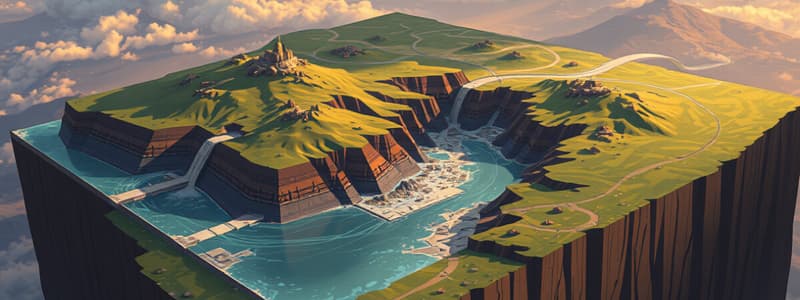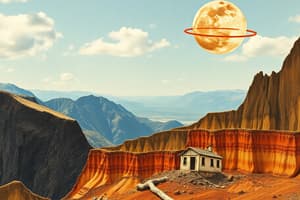Podcast
Questions and Answers
What occurs at divergent boundaries?
What occurs at divergent boundaries?
- Plates collide and one is forced beneath another.
- Plates move apart and new crust forms. (correct)
- Plates slide past each other horizontally.
- Mountain ranges are formed through uplift.
Which type of plate is generally thicker and less dense?
Which type of plate is generally thicker and less dense?
- Lithospheric Plates
- Transform Plates
- Continental Plates (correct)
- Oceanic Plates
What is the primary cause of earthquakes?
What is the primary cause of earthquakes?
- Erosion of landforms.
- Formation of volcanic islands.
- Movement of magma beneath the surface.
- Sudden movement along faults at plate boundaries. (correct)
Which statement about volcanic activity is true?
Which statement about volcanic activity is true?
What evidence supports the Continental Drift Theory proposed by Alfred Wegener?
What evidence supports the Continental Drift Theory proposed by Alfred Wegener?
What describes lithospheric plates?
What describes lithospheric plates?
What type of plate boundaries can lead to the formation of mountain ranges?
What type of plate boundaries can lead to the formation of mountain ranges?
Where do hotspots typically create volcanoes?
Where do hotspots typically create volcanoes?
Which of the following statements correctly describes oceanic plates?
Which of the following statements correctly describes oceanic plates?
At which type of plate boundary do plates slide horizontally past each other?
At which type of plate boundary do plates slide horizontally past each other?
What is the term for the point directly above the focus of an earthquake?
What is the term for the point directly above the focus of an earthquake?
Which of these effects is caused by the convergence of tectonic plates?
Which of these effects is caused by the convergence of tectonic plates?
Alfred Wegener proposed the theory that continents were once joined together as what?
Alfred Wegener proposed the theory that continents were once joined together as what?
Which type of volcano is typically formed at convergent boundaries where magma reaches the surface?
Which type of volcano is typically formed at convergent boundaries where magma reaches the surface?
What notable geological feature can form as a result of divergent tectonic plate movement?
What notable geological feature can form as a result of divergent tectonic plate movement?
Which characteristic is true for continental plates compared to oceanic plates?
Which characteristic is true for continental plates compared to oceanic plates?
What is primarily responsible for earthquakes occurring at plate boundaries?
What is primarily responsible for earthquakes occurring at plate boundaries?
Which geological phenomenon is generally associated with volcanic activity near tectonic plate boundaries?
Which geological phenomenon is generally associated with volcanic activity near tectonic plate boundaries?
Flashcards are hidden until you start studying
Study Notes
Tectonic Plates
Plate Boundaries
- Divergent Boundaries: Plates move apart; new crust forms (e.g., Mid-Atlantic Ridge).
- Convergent Boundaries: Plates collide; one plate may be forced beneath another (subduction), leading to mountain formation or volcanic activity (e.g., Himalayas).
- Transform Boundaries: Plates slide past each other horizontally; can cause earthquakes (e.g., San Andreas Fault).
Types Of Tectonic Plates
- Continental Plates: Thicker, less dense plates that form continents (e.g., North American Plate).
- Oceanic Plates: Thinner, denser plates that form ocean floors (e.g., Pacific Plate).
- Lithospheric Plates: Comprise both continental and oceanic crust; part of the Earth's lithosphere.
Earthquakes And Volcanoes
- Earthquakes: Result from sudden movement along faults at plate boundaries; measured by magnitude and intensity.
- Volcanoes: Form at convergent and divergent boundaries; involve magma reaching the surface (e.g., Mount St. Helens at convergent boundaries, Iceland on divergent boundaries).
- Hotspots: Areas where magma rises from deep within the Earth, creating volcanoes away from plate boundaries (e.g., Hawaiian Islands).
Continental Drift Theory
- Proposed by Alfred Wegener in the early 20th century.
- Suggests continents were once joined in a supercontinent (Pangaea) and have drifted apart over time.
- Evidence includes:
- Fossil distribution across continents.
- Similar rock formations and geological features.
- Climatological evidence (e.g., glacial deposits found in now-tropical areas).
- Led to the development of the modern theory of plate tectonics, which explains the movement of tectonic plates.
Plate Boundaries
- Divergent Boundaries: Characterized by plates moving apart, resulting in the formation of new crust, exemplified by the Mid-Atlantic Ridge.
- Convergent Boundaries: Occur when plates collide, often causing one plate to subduct beneath another, leading to the creation of mountain ranges or volcanic activity, as seen in the Himalayas.
- Transform Boundaries: Feature plates sliding horizontally past one another, which can result in significant earthquakes; the San Andreas Fault is a notable example.
Types of Tectonic Plates
- Continental Plates: These plates are thick and less dense, forming the continents, with the North American Plate as a prime example.
- Oceanic Plates: Thinner and denser, these plates make up the ocean floors; the Pacific Plate is a prominent representative.
- Lithospheric Plates: Consist of both continental and oceanic crust and constitute the Earth's lithosphere.
Earthquakes and Volcanoes
- Earthquakes: Arise from abrupt movements along faults at plate boundaries and are quantified by their magnitude and intensity.
- Volcanoes: Can develop at both convergent and divergent boundaries, where magma breaks through to the surface; Mount St. Helens is an example at a convergent boundary, while Iceland is prominent at a divergent boundary.
- Hotspots: Regions where magma rises from the Earth's interior, generating volcanoes away from tectonic plate boundaries, as illustrated by the Hawaiian Islands.
Continental Drift Theory
- Originated by Alfred Wegener in the early 20th century, proposing that continents were once unified in a supercontinent named Pangaea.
- The theory posits that continents have moved apart over geological time, supported by various evidence:
- Fossils found on different continents.
- Similar geological formations and structures across distant landmasses.
- Climatic evidence, such as glacial deposits existing in now-warm regions.
- This theory laid the groundwork for the modern understanding of plate tectonics, detailing the mechanics of plate movement.
Types of Tectonic Plates
- Lithospheric Plates: Rigid sections of Earth's lithosphere that can be either oceanic or continental in nature.
- Oceanic Plates: Thinner and denser than continental plates, predominantly composed of basalt; significant examples include the Pacific Plate and the Nazca Plate.
- Continental Plates: Thicker and less dense, primarily made of granite; notable examples include the North American Plate and the Eurasian Plate.
Plate Boundaries
- Divergent Boundaries: Characterized by plates moving apart, leading to the creation of new crust, exemplified by the Mid-Atlantic Ridge.
- Convergent Boundaries: Occur when plates collide, resulting in subduction or the formation of mountain ranges, such as the Himalayas.
- Transform Boundaries: Occur when plates slide horizontally past each other, causing friction and seismic activity, as seen in the San Andreas Fault.
Earthquakes and Volcanoes
- Earthquakes: Arise from the build-up and release of stress on faults, predominantly along plate boundaries.
- Focus: The point underground where an earthquake originates.
- Epicenter: The location directly above the focus on the Earth’s surface.
- Volcanoes: Primarily formed at convergent and divergent boundaries due to the ascent of magma to the surface.
- Types of Volcanoes: Include shield volcanoes (broad and gently sloping), stratovolcanoes (tall and steep-sided), and cinder cone volcanoes (small and steep).
Continental Drift Theory
- Introduced by Alfred Wegener in the early 1900s, proposing that continents were once unified as a supercontinent named Pangaea before drifting apart.
- Evidence supporting this theory includes:
- Similar fossils discovered on distant continents, indicating historical connection.
- Geological formations that match across continents, suggesting shared tectonic history.
- The complementary shape of continental coastlines, particularly between South America and Africa.
Effects of Plate Movement
- Mountain Building: A consequence of the convergence of tectonic plates, resulting in the formation of extensive mountain ranges.
- Earthquake Activity: Increased seismic incidents frequently occur along plate boundaries due to stress release.
- Volcanic Activity: Leads to the creation of volcanic arcs and islands as magma reaches the surface.
- Ocean Basin Formation: Occurs as a result of divergent plates, leading to the development of new ocean basins and mid-ocean ridges.
- Tsunamis: Can be triggered by underwater earthquakes, posing significant risks to coastal regions.
Studying That Suits You
Use AI to generate personalized quizzes and flashcards to suit your learning preferences.




